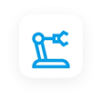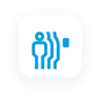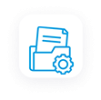With the pandemic literally halting business operations worldwide, organizations rapidly started adopting technology and automation to keep their critical business processes running. One of the heavily discussed topics in the wake of these disruptions is the push for robots in delivery services. Robots have already proved their efficiency in factory settings to carry out several production tasks. However, bringing these intelligent machines outside of the factory floor and programming them to deliver packages at customers' doorsteps will completely change the landscape of the courier and delivery industry.
Companies across the globe are turning the idea of robots for deliveries into a reality. Let’s explore some of the notable innovations in this field to get a glimpse of what the future of delivery services may look like.
Autonomous Robots for Delivery Services
The question of when robots will deliver packages is already answered. Starship Technologies, an autonomous delivery company, started in 2014, brought in their robots to undertake deliveries in Milton Keynes, UK.
The six-wheeled robot started delivering packages in mid-March 2020. The robots also helped supermarkets to get their products to customers amidst the nationwide lockdown. These bots have already completed 100,000 autonomous deliveries and traveled more than 500,000 miles.
Unity Drive Innovation, a company based in China, enabled shops to deliver products to their customers through robotics technology. The company created an autonomous van that uses a range of sensors like LiDAR, Cameras, and IR blasters to find its way on the roads of China. The autonomous van has so far completed 2,500 autonomous trips successfully.
Amazon Scout is the e-tailer giant’s step into autonomous delivery. The Scout is a 6-wheeled autonomous robot that travels on the sidewalk of the road. Scout is used for last-mile deliveries, aiming to deliver packages to customers’ doorsteps from a delivery van parked in the neighborhood. The delivery robot uses a mixture of high-resolution images with its camera, onboard sensors, machine learning, and GPS to navigate the sidewalk accurately. The robot can also move onto the street if it finds something or someone blocking the sidewalk.
There are several other companies in the world working on autonomous delivery robots. Nuro, Kiwibot, TeleRetail, Udelv, Eliport, and Postmates Serve are some of the most popular ones.
Drones for Delivery
Drones are increasingly effective in autonomous delivery services. However, their market penetration is slow due to different government regulations. Despite the limitations, innovation is at its peak in this area. Companies are now developing drones that comply with regulations.
Wing, a subsidiary of Alphabet, was the first drone operator to be certified as an air carrier in the United States. The Wing Drone is currently operational, and customers can see whether their service is available in their area using the Wing app.
Amazon is also investing heavily in the drone market. In August of 2020, the company received approval from the FAA to operate in the United States. Currently, Prime Air can deliver packages weighing up to 5 pounds in 30 minutes or less!
The Future for Autonomous Delivery Systems
The global autonomous last-mile delivery market is expected to be valued at $11.90 billion in 2021 and is projected to reach $84.72 billion by 2030, registering a CAGR of 24.4%. The pandemic has played a large role behind these numbers and is boosting the projects for autonomous delivery robots.
Before the pandemic, there were concerns about how such a technology can be implemented. However, with social distancing norms and cities under lockdowns, these inventions showed they have a place in the grand scheme of eCommerce.
With the present use cases and larger profit margins, we’ll see more developments in autonomous technology for last-mile deliveries and logistics through autonomous delivery trucks. As the world adopts these new last-mile logistics systems, cities will become more efficient and sustainable by replacing carbon-emitting vehicles with light and efficient carbon-free autonomous vehicles.
The Role of Sensor Technology in the Future of Autonomous Delivery
Autonomous robots and drones use sensors and GPS to navigate their way, avoiding any collisions on their way. With the advancements in sensor technology, robots are getting smarter and better at identifying their surroundings. Technologies like LiDAR are very effective at measuring range. LiDAR sensors use laser light pulses to measure the distance from the objects and enable delivery robots to detect obstacles and change their paths when needed.
Cameras are the next set of sensors that delivery robots and drones utilize. With the available hardware today, cameras are capable of taking multiple high-resolution images per second. These images are then fed into the machine learning system to map out the robot’s environment better.
As autonomous delivery systems continue to mature, the role of these sensors will continue to be of significant importance in the future to enable these systems to operate with better accuracy and efficiency.
Choose the Best in Sensor Technology for Building Your Next Delivery Robot
It’s inevitable from the trends that the future of robots in delivery is bright and promising. However, building the next generation of delivery robots also requires dependable sensor technology. At Hokuyo, we offer robust sensor products purpose-built for a range of indoor and outdoor robotics applications, including factory automation, logistics automation, and packaging automation.
Explore some of our smart sensing solutions for autonomous robotics, or contact us to learn more.

 Factory Automation
Factory Automation Logistics Automation
Logistics Automation Process Automation
Process Automation Crane Collision Avoidance
Crane Collision Avoidance LiDAR/Obstacle Detection
LiDAR/Obstacle Detection Safety Laser Scanners
Safety Laser Scanners Optical Data Transmission
Optical Data Transmission Hot Metal Detectors
Hot Metal Detectors Laser Distance Sensor
Laser Distance Sensor Blog
Blog Whitepapers
Whitepapers Case Studies
Case Studies Infographics
Infographics